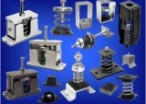NOISE AND VIBRATION CONTROL

VIBRATION ISOLATORS
KIP Blocks – “Fiber Glass”
Inorganic fiber glass media.
Flexible elastomer coating.
Constant natural frequency in wide load range.
Permanent and pre-determinable resilience.
Pre-determinable dynamic response.
High power dissipation.
Viscous controlled "Damping".
Load capacity from 0.07 to 35 kg/cm2 (1 to 500 PSI).
Description:
The KIP "pad", manufactured using the KINETICS NOISE CONTROL technology, is superior to all other types of "pads" developed to date. It is dynamically pre-determinable and keeps up with constant characteristics throughout their useful life. Manufactured by precise methods using inorganic materials. This type of isolation allows freedom of design, form and unprecedented use by any other similar isolator. Consist of molded and pre-compressed high density fiberglass matrix, individually coated with a flexible and waterproof elastomeric membrane and designed to allow controlled movement of air among the glass fibers. The pumping action of the air between the fibers results in viscous damping, reducing the movement caused by shock and vibration.
A wide range of "pads" with different densities and spring effects is available to meet load capacities from 0.07 to 35 kg/cm2 (1-500 PSI). The annealed glassfiber from isolation means are produced by a multiple flame attenuation process generating fibers with elastic modulus of 10.5 million PSI (738.223 kg / cm2) and nominal fiber diameters smaller than 0.00027 "(6.8 microns). The fiberglass matrix with spring effect is bonded to all intersections of the fibers with a waterproof resin during molding process under controlled heat and pressure. The material is stabilized after ten (10) pre-compression cycles with three (3) times the nominal load capacity of the "pads".
The KIP isolators are the ones that allow a wide range of load capacity while maintaining a constant natural frequency. The natural frequencies of the fiberglass means of KIP isolators are controlled by the density of the isolator rather than the static deflection as in the case of steel springs.
To determine the natural frequency related to isolation thickness different than 1 "(25 mm), the natural frequency of the isolator of 1" thick is divided by the square root of the current thickness to be used. For example: The natural frequency of an isolator with a thickness of 4" is half the natural frequency of an 1" isolator subjected to the same load and the same density of the media.
KIP is "unique" as a structural support once the applied loads are substantially lower than the pre-compression loads, providing a safety factor of 300% overload or more.
The result is permanent resilience and constant natural frequency.
The KIP is non-corrosive, non-combustible, non-hygroscopic and resistant to rust, ozone, mold, fungi, pests, insects and rodents. It does not shrink, swell nor decomposes. The isolating characteristics are constant within the range of 4 ° C to 121 ° C (-40 ° F to 250 ° F).
Applications:
The KIP isolators can be applied to a wide variety of uses such as isolation of vibration, noise and impact. It is recommended whenever it is important to obtain a predetermined dynamic response and constant of the load support.
Typical KIP applications:
• Noise isolation includes use in floating floors, as high efficiency "pad" interrupting the transmission of noise from suspended "hangers" and as supports for mechanical equipments seated on the ground.
• As shock isolation (impact), includes the use of KIP as support for mechanical presses, shears for cutting sheet metal and other industrial machines.
• As vibration isolators, are as supports and brackets for high speed fans, hydraulic pumps and chillers seated on the floor with operating speeds above 1700 rpm.
The KIP isolators are available in a range of standard configurations and special settings for various load ranges, natural frequencies and physical configurations.


 Portuguese
Portuguese